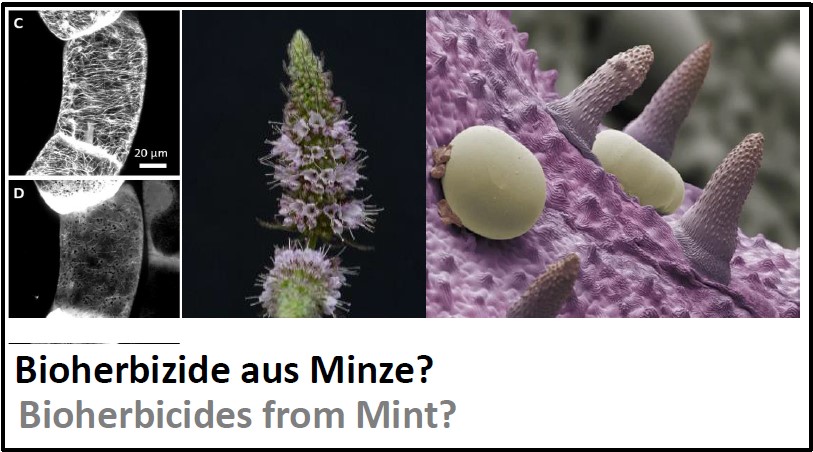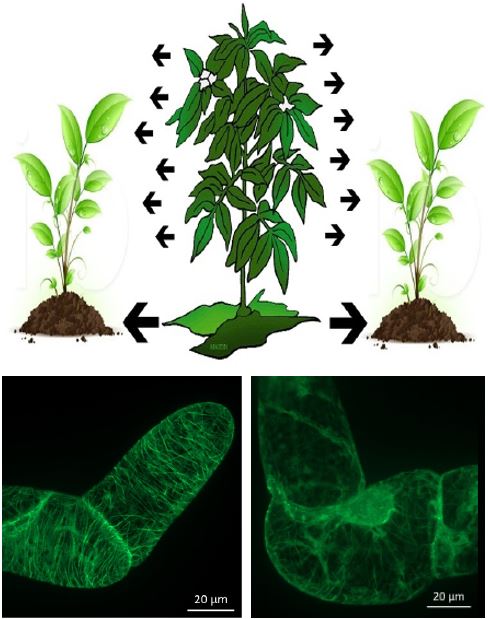 Plant Evolution 2023
Plant Evolution 2023
Peppermint (Mentha x piperita) is a natural hybrid from Spearmint (Mentha crispa) and Watermint (Mentha aquatica). The three species differ in the composition of their essential oil as shown by Nathalie Hering in her PhD thesis. She could show that the expression of monoterpene synthases differs, although the genes are all present. We think, therefore, that regulatory factors differ. A hybridisation often leads to genome interactions that will silence certain parts of the genome. Nathalie Hering could show that different enzymes of the pathway are activated to a different extent in the three species, which can explain the chemical differences. The project deals with geranyldiphosphat-synthase triggering a common precursor. This tells us, to what extent the entire pathway is activated. The enzyme is a heterodimer (Burke et al., PNAS), and its specificity depends on specific amino acids in the active centre (Ueoka et al., Plant Physiology), and has already been used for metabolic engineering (Fuchs et al., Frontiers Plant Sci) such that there is already functional information. The expression of monoterpenoid pathway genes in glandular hairs of Mint is driven by their promoter sequences (Qamar et al., Planta). It is likely that also the temporal pattern depends on motives in the promoters. Therefore, the expression pattern of geranyldiphosphate-synthase is of interesting, and cDNA templates from a developmental series has been already generated. The task would be to get a viable data set on the expression pattern of this enzyme. One can learn typical steps needed for a molecular expression study, including, primer design and standardisation, quality testing by semi-qPCR and quantification by real-time qPCR. In parallel, the allelopathic effect of the final products (species-specific monoterpenes) would be investigated.
Materials: Artikel in Biologie unserer Zeit . Burke et al., PNAS (biochemistry of GPPS) . Ueoka et al., Plant Physiology (substrate specificity) . Fuchs et al., Frontiers Plant Sci (Metabolic engineering of Mint monoterpenes with functional data) . Qamar et al., Planta (promoters driving the expression of monoterpenoid pathway genes in glandular hairs of Mint).
Minzen - Von After Eight zum Bioherbizid
Industrialised agriculture is vulnerable to weeds requiring intense herbicide use, which not only causes high costs, but also leads to pesticide residues. Prolonged use of herbicides will also select for weeds that are tolerant. Meanwhile, several herbicide classes have been banned in the European Union, due to their unfavourable ecotoxicology and persistence in the environment. Alternative and novel mode of actions are therefore urgently required.
The current approach is more or less "biocidal", specificity is not very tight, and caused, for instance, because the compound can penetrate into the weed more easily than into the crop. We go for a new strategy, which is based on compounds that hijack biological signalling, which allows for higher specificity and, thus, for a higher degree of ecological safety. Weeds are problematic, because they compete with crops for the same ecological niche. Competition has been a central issue during plant evolution. Natural biodiversity has already developed such strategies that are sustainable, because they had been tested in a multiscalar manner over millions of years. We just have to reshape this strategy for agricultural use.
Mint (Mentha) is very efficient in outcompeting other plants (allelopathy). We have shown that this competitiveness is linked with efficient suppression of seed germination of dicots. Using a cell culture system, we can see further that those mint oils that block germination, induce rapid cell death linked with a rapid degradation of the cytoskeleton. Next, these oils have been investigated by Gas Chromatography coupled to Mass Spectrometry. This allowed us to identify compounds that are found in active species and lack in the inactive species (so called activity-guided fractionation). For several of these compounds, we could show already that they are inducing the same responses. From this work, currently two foci have emerged:
We have found a particular mint species that very efficiently eliminates actin filaments. In efficiency studies at the Federal Institute for Biological Agriculture (FiBL) in Frick, Switzerland, this essential oil has been found to block efficiently the regeneration of Convolvulus, a pertinent weed, which is spread by fragments of the shoot during ploughing and hard to suppress. The active compound is not clear yet, there might be a synergy of two or more compounds.
The activity-guided fractionation strategy was identifying a mint compound, which efficiently suppresses microtubules. This compound was very efficient in blocking germination of weeds. Of special interest is the high efficiency against Rumex, a pertinent weed on mountain pastures.
Since allelopathy has to be specific (the source plant would otherwise kill itself), it must work on signalling. Future work will be dedicated to dissect the underlying signalling pathways and to develop further applications. One important topic is the formulation - essential oils are volatile (this is their nature), so we are currently working at different carriers that provide slow and steady release in agricultural systems.

